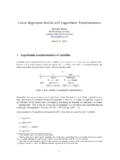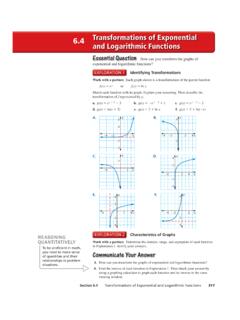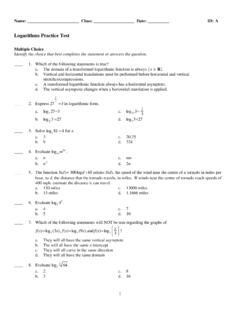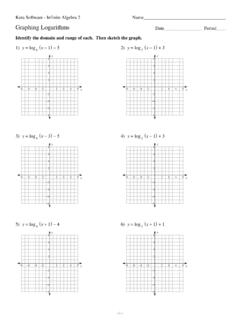Transcription of 4.1 Exponential Functions (-1, 1/a)(1,a) -2 (1,a ...
1 4. Exponential and logarithmic Functions Exponential Functions A function of the form f(x) = ax, a > 0 , a 1 is called an Exponential function. Its domain is the set of all real numbers. For an Exponential function f we have axfxf )()1(. The graph of an Exponential function depends on the value of a. a> 1 0 < a< 1 Points on the graph: (-1, 1/a), (0,1), (1, a) Properties of Exponential Functions 1.
2 The domain is the set of all real numbers: Df = R 2. The range is the set of positive numbers: Rf = (0, + ). (This means that ax is always positive, that is ax > 0 for all x. The equation ax = negative number has no solution) 3. There are no x-intercepts 4. The y-intercept is (0, 1) 5. The x-axis (line y = 0) is a horizontal asymptote 6. An Exponential function is increasing when a > 1 and decreasing when 0 < a < 1 7. An Exponential function is one to one, and therefore has the inverse. The inverse of the Exponential function f(x) = ax is a logarithmic function g(x) = loga(x) 8.
3 Since an Exponential function is one to one we have the following property: If au = av , then u = v. (This property is used when solving Exponential equations that could be rewritten in the form au = av.) Natural Exponential function is the function f(x) = ex, where e is an irrational number, e The number e is defined as the number to which the expression nn)1(1 approaches as n becomes larger and larger. Since e > 1, the graph of the natural Exponential function is as below -5-4-3-2-112345-5-4-3-2-112345xy(-1, 1/a)(1,a)-5-4-3-2-112345-5-4-3-2-112345x y(-1, 1/a)(1,a) Example: Use transformations to graph f(x) = 3 -x - 2.
4 Start with a basic function and use one transformation at a time. Show all intermediate graphs. This function is obtained from the graph of y = 3x by first reflecting it about y-axis (obtaining y = 3-x) and then shifting the graph down by 2 units. Make sure to plot the three points on the graph of the basic function! Remark: Function y = 3x has a horizontal asymptote, so remember to shift it too when performing shift up/down y = 3x y = 3 x y = 3 x - 2 Example: Use transformations to graph f(x) = 3e2x-1.
5 Start with a basic function and use one transformation at a time. Show all intermediate graphs. Basic function: y = ex y = ex-1 (shift to the right by1) -5-4-3-2-112345-5-4-3-2-112345xy(-1, 1/e)(1,e)y= e2x-1 (horizontal compression 2 times) y = 3e2x-1 ( vertical stretch 3 times) Example: Solve xx242 (i) Rewrite the equation in the form au = av Since 4 = 22, we can rewrite the equation as xx2222 Using properties of exponents we get xx2222.
6 (ii) Use property 8 of Exponential Functions to conclude that u = v Since xx2222 we have 2x2 = x. (iii) Solve the equation u = v 01200)12(02222 xxxxxxxx 2/1 x Solution set = {0, } logarithmic Functions A logarithmic function f(x) = loga(x) , a > 0, a 1, x > 0 (logarithm to the base a of x) is the inverse of the Exponential function y = ax. Therefore, we have the following properties for this function (as the inverse function) (I) y = loga (x) if and only if ay = x This relationship gives the definition of loga(x): loga(x) is an exponent to which the base a must be raised to obtain x Example: a) log2(8) is an exponent to which 2 must be raised to obtain 8 (we can write this as 2x = 8) Clearly this exponent is 3, thus log2(8) = 3 b) log1/3(9) is an exponent to which 1/3 must be raised to obtain 9: ( 1/3 )x = 9.
7 Solving this equation for x, we get 3 x =32, and x = 2 or x = -2. Thus log1/3(9) = -2. c) log2(3) is an exponent to which 2 must be raised to obtain 3: 2x = 3. We know that such a number x exists, since 3 is in the range of the Exponential function y = 2x (there is a point with y-coordinate 3 on the graph of this function) but we are not able to find it using traditional methods. If we want to refer to this number, we use log2(3). The relationship in (I) allows us to move from exponent to logarithm and vice versa Example: - Change the given logarithmic expression into Exponential form: log2x = 4 The Exponential form is: 24 = x.
8 Notice that this process allowed us to find value of x, or to solve the equation log2(x) = 4 - Change the given Exponential form to the logarithmic one: 2x = 3. Since x is the exponent to which 2 is raised to get 3, we have x = log2(3). Note that the base of the exponent is always the same as the base of the logarithm. Common logarithm is the logarithm with the base 10. Customarily, the base 10 is omitted when writing this logarithm: log10(x) = log(x) Natural logarithm is the logarithm with the base e (the inverse of y = ex): ln(x) = loge(x) (II) Domain of a logarithmic function = (0, ) (We can take a logarithm of a positive number only.)
9 Range of a logarithmic function = (- , + ) (III) loga(ax) = x, for all real numbers xaxa )(log, for all x > 0 Example log225= 5, lne3= 3, 23)2(log3 , eln7 = 7 (IV) Graph of f(x) = loga(x) is symmetric to the graph of y = ax about the line y= x a > 1 0 < a < 1 Points on the graph of y = loga(x) : (1/a, -1), (1,0), (a, 1) (V) The x-intercept is (1, 0).
10 (VI) There is no y-intercept (VII) The y-axis (the line x = 0) is the vertical asymptote (VIII) A logarithmic function is increasing when a > 1 and decreasing when 0 < a < 1 (IX) A logarithmic function is one to one. Its inverse is the Exponential function -5-4-3-2-112345-5-4-3-2-112345xy(-1, 1/a)(1,a) y = axy=x(1/a, -1)(a,1)y = loga(x)-5-4-3-2-112345-5-4-3-2-112345xy( -1, 1/a)(1,a) y = axy=x(1/a, -1)(a,1)y = loga(x)(X) Because a logarithmic function is one to one we have the following property: If loga(u) = loga(v), then u = v (This property is used to solve logarithmic equations that can be rewritten in the form loga(u) = loga(v).)









